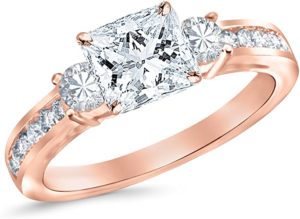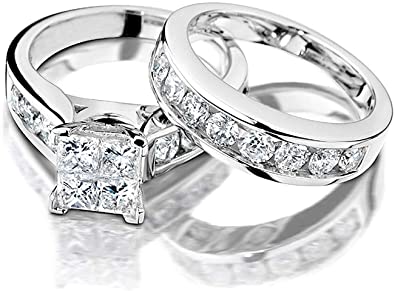
Congratulations on your impending nuptials!
Indeed, you’ve made one of the most important decisions in your life. I bet that part of your preparations towards this momentous occasion involves hitting jewelry stores downtown to shop for an exquisite piece of diamond.

You deserve another pat on the back for choosing to treat her like the queen that she is. But before you go shopping for diamonds, you should familiarize yourself with the top aspects to look out for. These factors are commonly summed up as the Four Cs and include the elements of Cut, Color, Carat weight, and Clarity.
Out of the Four Cs, the cut and carat weight of a diamond are the two most important ones. That’s because they influence the overall light performance, value, and price of diamonds.
Now, there are more than ten officially-identified diamond cuts out there. One of these is the Princess Cut and in this post, we shall offer a few insights on how to choose a Princess Cut Diamond.
What Are Princess Cut Diamonds?
Princess Cut Diamonds refer to diamonds that are faceted by polishing the inverted pyramids of rough diamond stones. Due to their inverted pyramid appearance, much of the weight of princess cuts rests on the pavilion. So, if compared side by side with other diamond cuts, the face-up appearance of princesses often appear smaller. We shall see later on what that means in terms of the light performance of these diamonds.

The facets in a princess cut diamond can be as few as 57 or as many as 76, depending on the skills of the polisher and the desired performance of the stone. These diamonds sport a straight-sided rectangular outline that’s completed with a brilliant-style arrangement of facets. However, princesses can also come in a square as well as other fancy shapes. And the shape that you choose should largely depend on your preferred ring setting.
Unlike most diamond cuts, the princess cut is relatively new. The cut was developed by renowned jewelers – Betzalel Ambar and Israel Itskowitz. Princesses were seen as the more elegant alternatives to the classic round cuts.
How to Choose a Princess Cut Diamond
Numerous factors go into choosing a suitable princess cut diamond for you. The following are some of these factors;
1. Shape
The first consideration when selecting any diamond cut is the shape of the stone. But first things first – it’s important to emphasize that diamond shape and cut isn’t the same thing, much as the two terms are often used interchangeably.
Diamond shape refers to the outline of a diamond as perceived by the observer’s eye. The shape of a diamond is simply the external figure. On the other hand, a diamond cut refers to the facets, symmetry, and dimensions of the diamond. The shape is mostly used to describe a diamond’s physical appearance, while the cut describes the stone’s reflective properties. However, these two concepts are almost intertwined.
As we already mentioned, princess cuts can either come square or rectangular. If you’re a newcomer in diamonds, you should avoid princesses with tapered sides and settle for the more square ones. That will mean familiarizing yourself with another concept known as length to width ratio.
The length to width ratio of a diamond refers to the ratio that’s obtained after dividing the length of that diamond with its width.
For instance, if a diamond measures 15 mm long and 9 mm wide, the length to width ratio can be worked out as follows;
>Length to Width ratio = Length/ Width,
> 15/9,
>1.88.
The length to width ratio of a diamond is useful in determining how proportionate the stone is. In princess cut diamonds, the ideal length to width ratio is between 1:05 and 1. Within this range, the princess has more even sides and equal proportions. The diamond is not only aesthetically appealing but also handles light reasonably well, which speaks to its sparkle and brilliance.
2. Carat
Princess cut diamonds may appear larger than round diamonds. But they don’t sparkle as much. That’s because princesses have smaller pavilions that don’t refract light as well as other diamond cuts do.
So, if you’re purchasing princess cut diamonds, you may have to shell out more money on higher carat weight. Fortunately, there’s a saving grace. The price of princesses tends to be cheaper compared to that of most other diamond cuts. That’s because when cutting and polishing these diamonds, less material goes to waste.
3. Color and Clarity
Princess cut diamonds are polished to deliver maximum brilliance. As such, they don’t hide color tints and blemishes very well. So, when choosing a princess cut, insist on a diamond with no visible yellow tints. Focus on a stone that’s as close to D on the diamond color scale as possible. A princess with a grading of G, H, I, and J is fine, but don’t go any lower.
Similarly, avoid stones with visible blemishes and inclusions. If you can, ensure your princess is graded VS1 or VS2. If there must be inclusions, ensure they don’t occur at the corners of your diamond. Princess cuts are known to have fragile corners, and blemishes around those corners could weaken them even further.
4. Symmetry
You can examine the symmetry of a diamond casually by drawing an imaginary line vertically through the diamond. Then, check if the line splits the stone into two equal halves. Besides being of equal shapes and sizes, each of the halves must also contain similar facets.
If you’re satisfied, repeat the process, only this time you draw the line horizontally so that you’re comparing the upper and lower halves.
But if you find this strategy difficult to execute, you might as well choose to rely on the diamond grading report. The report will offer you more insights on how symmetrical the proportions of the princess cut diamond are. While you’re at it, settle for a symmetry grade of no less than Good.
5. Scintillation
Scintillation refers to a balanced contrast between the patterns of light and dark in the facets and table of a diamond. Now, it’s true that much of the weight of a princess cut rests on its pavilion. So, it’s logical to imagine that the diamond will have more sparkle around its pavilion.
However, your princess cut should still have a fairly balanced contrast between its dark and light patterns. Too dark patterns will deny your diamond its sparkle, whereas too light patterns will be harsh on your eyes.
6. Pavilion
The pavilion of your princess cut diamond should not bulge. To make sure of that, observe the diamond from the side through a 10x loupe.
Check if the pavilion slopes gently from the diamond’s girdle to its culet. A steep pavilion can create a pavilion bulge, which reduces the diamond’s overall scintillation.
7. Ring Mounting
Lastly, your princess cut diamond deserves an appropriate ring setting. Princesses tend to have delicate corners that are prone to chipping.
As such, go for a suitable mounting such as V-shaped prong settings where all the four corners are securely held within the prongs.
Wrap Up
Choosing a suitable princess cut diamond, as is with any diamond cut, requires a bit of patience and diligence. We hope you can implement the tips we’ve shared here while shopping for your next princess.





